On our beautiful Resarö island, there has been a famous historic mine, unkown to many.
In this Ytterby mine, located on Resarö in Vaxholm Kommun, outside Stockholm nine elements were discovered here for the first time in history:
- Yttrium (named after Ytterby)
- Ytterbium (named after Ytterby)
- Terbium (named after Ytterby)
- Erbium (named after Ytterby)
- Holmium (named after Holmia, the Latin name for Stockholm)
- Scandium (named after Scandinavia)
- Thulium (named after Thule, the Latin name for Scandinavia)
- Gadolinium (named after the chemist Johan Gadolin)
- Tantalum (named after the Greek mythological figure Tantalus)
Ytterby is the place in the world that has the most elements named after him, that is four.
In 1843 discovered the Swedish chemist Carl Gustaf Mosander two elements yttrium (Y), terbium (Tb).
Later in 1878 Swiss Jean-Charles Galissard the Marignac discovered a component called ytterbia from which latter element Ytterbium (Yb) was separated.
And finally in 1879 Swedes Per Teodor Cleve and Lars Fredrik Nilson discovered the elements erbium (Er), holmium (Ho), scandium (Sc) and thulium (Tm).
In 1989 the Ytterby mine was pointed out as a historic site by ASM International. At the mine entrance was installed a commemorative plaque.

Ytterby Gruvan information sign on Ytterbyvägen, Resarö in Vaxholm

Detail information about Ytterby Mine

The way up to the mine from Ytterbyvägen

Near the remainings of the mine
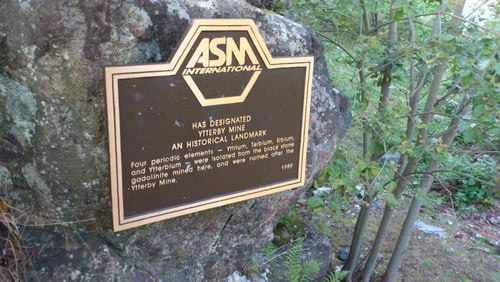
Memorial plaque of the ASM International society at the entrance of Ytterby mine
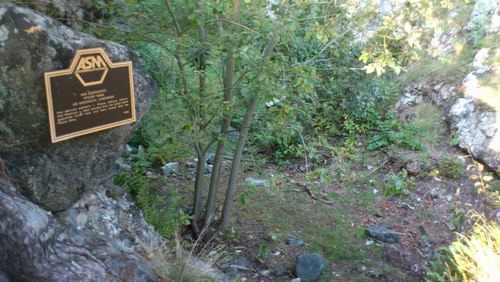
View on the remainings of the mine
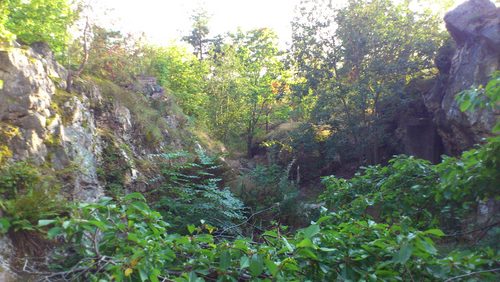
View on the remainings of the mine

View from above

View from the top of the hill towards Vaxholm
The Ytterby mine on Resarö was opened already in the 17th century when quartz was mined for the iron works in the north of Uppland. In the 18th century, the mining of quartz was replaced by that of feldspar. It was the nearby porcelain factory Gustavsberg and Rörstrand that needed the raw material which was supplied until the mine closed down in 1933. But it wasn’t the feldspar that made the mine world famous. In 1787, the Swedish lieutenant Carl Axel Arrhenius from Vaxholm discovered some very heavy black rocks in the mine. He sent some samples to professor Johan Gadolin at the university in Åbo in Finland, which was a part of Sweden at that time. Gadolin analysed the mineral and found the first of the “rare earth metals” in the sample. Thanks to his discovery, the mineral was named Gadolinite´. The chemical formula was later determined to Y2FeBe2Si2O10, and it was Yttrium that was the new previously unknown metal.
Gadolinite can have slightly different compositions, so that Yttrium is replaced by other rare earth metals. With time, better methods of analysis resulted in the discovery of several more elements in the samples from Ytterby. Four of them got their names from the mine: Ytterbium, Yttrium, Erbium and Terbium. No less than eight of the 92 more or less naturally occurring elements were discovered thaks to samples from the mine. No other place on earth has produced that many new elements, and that is why this small mine is a must stop for all new Nobel Prize Laureates in Chemistry and Physics when they come to Stockholm. The mine has an other connection to the Nobel Prize as well. The porcelain that the dinner is served on comes from Gustavsberg, the factory that was the reason for the existence of the Ytterby mine!
Today, only some rocks are visible at the site, but if you own a Geiger counter you can detect that there is some radioactivity at the place. It is small amounts of Uranium and Thorium that gives the radioactivity, two elements that were not discovered here but that forms a part of the complicated element cocktail that is hidden within the mountain. The mine itself is sealed and has been used as a storage room for large amounts of oil, but it is now empty. The tower that you see on top of the mountain is a fan that ventilates the last fumes of the remaining oil from the old mine.

The black rock…
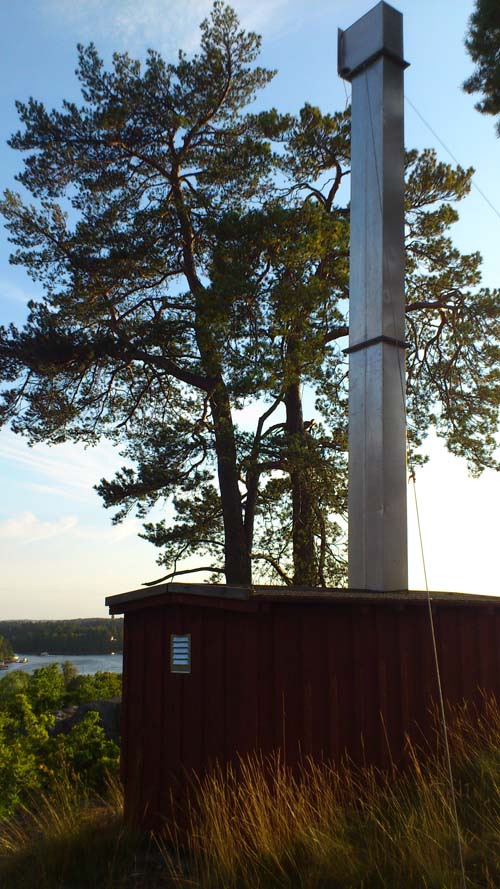
The ventilation tower on top of the old mine
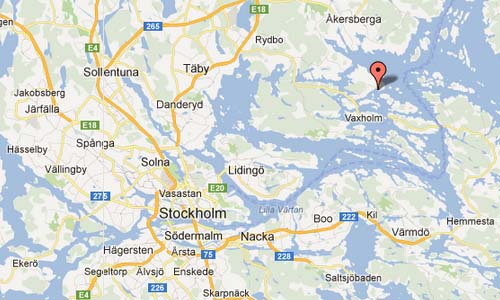
Ytterbyvägen in Ytterby on Resarö near Vaxholm
39 Yttrium Y – Periodic Table Videos (from www.periodicvideos.com)
65 Terbium Tb – Periodic Table Videos (from www.periodicvideos.com)
70 Ytterbium Yb – Periodic Table Videos (from www.periodicvideos.com)
68 Erbium Er – Periodic Table Videos (from www.periodicvideos.com)
67 Holmium Ho – Periodic Table Videos (from www.periodicvideos.com)
23 Scandium Sc – Periodic Table Videos (from www.periodicvideos.com)
69 Thulium Tm – Periodic Table Videos (from www.periodicvideos.com)
More information and sources:
– Vaxholms Hembygdsförening: Ytterby gruva,
– Länsstyrelsen i Stockholms län: Ytterby varphögar,
– Geocaching.com: The Greatest Little Mine in the World,
– M Teknik: Ytterby gruva – ett industriminnesmärke,
– Miras Mirakel: Ytterby gruva – en nobel sevärdhet
– Ytterby gruva – Kultur- och industrihistorisk dokumentation



 Posts
Posts